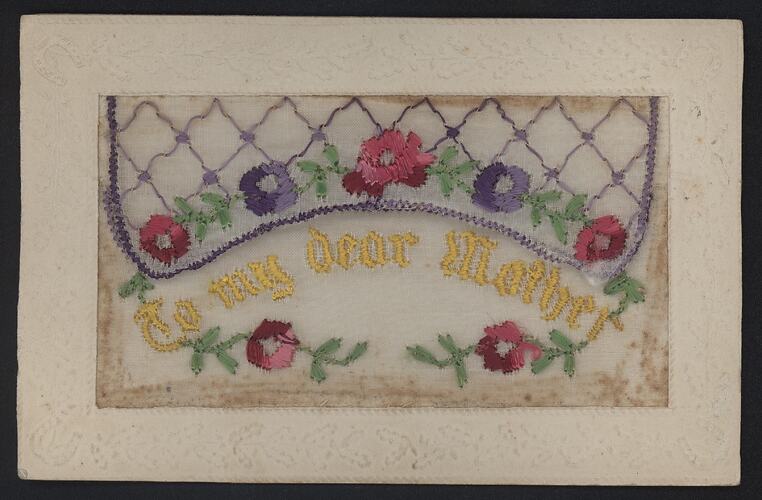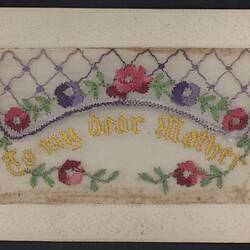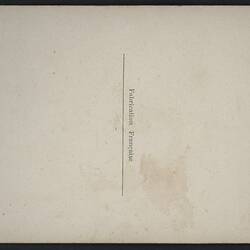Summary
Embroidered postcard with muslin flap, inscribed 'To My Dear Mother'. As this postcard remains blank it is not known whether it was sent home uninscribed or whether it was brought home unused. The presence of a pocket on the front of the postcard suggests that a smaller card may have been enclosed, it is therefore possible that it was sent home and the missing card was inscribed.
According to the Australian War Memorial, the popularity of embroidered postcards (first made for the Paris Exposition in 1900) peaked during World War I. Many were 'embroidered by French women in their homes and then sent to the factories for cutting and mounting on postcards'. Common themes included family, remembrance, liberty, unity and war souvenirs.
Description of Content
Three pink flowers with two purple ones in between them, connected by green stems and leaves, against a purple netted background on the upper piece of muslin. A yellow inscription on the lower piece, with two pink flowers underneath text, and green stems and leaves that connect to floral design in upper segment. The cardboard border contains patterns with leaves, with horseshoes in each corner.
Physical Description
A cardboard postcard with two pieces of muslin with purple lining attached to the top and bottom of patterned cardboard border. Colourful images and text sewn onto muslin; top piece opens upwards. The back of the postcard displays printed text with a dividing-back.
Significance
Embroidered postcards were very popular during World War I, with common themes including family, remembrance, liberty and unity. Their popularity began to wane after the war and they are not found after c.1923, making embroidered postcards a souvenir unique to World War I.
More Information
-
Collecting Areas
-
Acquisition Information
Purchase
-
Place & Date Made
-
Format
Postcard
-
Inscriptions
Embroidered in yellow cursive text on the front of the postcard: 'To my dear mother' Printed in black ink along the centre dividing line on the back of the postcard: 'Fabrication Francaise'
-
Classification
-
Category
-
Discipline
-
Type of item
-
Overall Dimensions
139 mm (Width), 90 mm (Height)
-
Keywords
Embroidery, Postcards, Families, Souvenirs, World War I, 1914-1918


